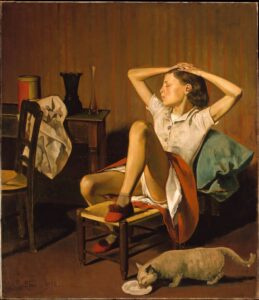Jorge Benitez
In the 1960s, American art writing moved from the passionate polemics of Clement Greenberg and the clarity of Harold Rosenberg to the erudite incomprehensibility of Rosalyn Krauss and the brilliant ennui of Susan Sontag. In Europe, thinkers ranging from Jean-François Lyotard to Roland Barthes addressed the role of author and artist within what seemed like the end of the Grand Western Narrative. Concurrently, the counterculture and new human and civil rights movements held the promise of sociopolitical and cultural renewal. Art and art writing were destined to move forward. The avant-garde had stood for progress since the dawn of modernism, and the retrogressions of the post-war era could not stand in the way. The Age of Aquarius said as much…until it ran out of steam.

By the late seventies, a still-unknown virus called HIV threatened the sexual revolution while internecine warfare pushed the women’s movement from the pragmatism of Betty Friedan toward utopian radicalism. The Reagan years accelerated the commodification of the arts through what New Art Examiner co-founder Derek Guthrie calls the “Americanization of the avant-garde.” Like Disney and Coca-Cola, art became democratic…for a price. Art writing followed suit as it took money from sources it pretended to despise. Throughout the 1980s and 90s a new alliance of corporate and philanthropic entities financed a necessary and healthful inclusion of overlooked artists from marginalized communities. Again, art writing rode the wave. But instead of providing genuine criticality, it soon surrendered to a Jean-Jacques Rousseau-like romanticization of the exploitable other. Pity, disguised as social justice, found a profitable voice.
In art, the politics of pity is more harmful than the politics of hate. Pity is soporific. Hate, like persecution and censorship, can be a catalyst for greatness. From Francisco Goya to Max Beckman, tragic art emerges from the hate-filled absurdities of its time. Pity undermines the power of art with manipulative sentimentality and allows otherwise insensitive revolutionaries to appear compassionate and virtuous. Hannah Arendt addressed the connection between revolutionary pity and callousness when she wrote: “Pity, taken as the spring of virtue, has proved to possess a greater capacity for cruelty than cruelty itself.”1 A few sentences later Arendt added that revolutionaries were “curiously insensitive to reality in general and to the reality of persons in particular, whom they felt no compunction in sacrificing to their ‘principles’, or to the course of history, or to the cause of revolution as such.”2 Yet even Arendt could not have foreseen the power and truth of her observations in the 21st century.
By the late 1990s, pity had joined forces with a misunderstanding of French philosophers, such as Michel Foucault, to produce a new artistic trend: the medicalization of the avant-garde, a condition that labeled divergent critical views as phobias while emphasizing identity and victimhood. Social and personal pain became objects of minute analysis intended to hold someone accountable, elicit pity from the viewer, and monetize the real and invented traumas of artists and their advocates. The artist-as-social-worker became a vehicle for critics and curators indulging in therapeutic activism. The resulting infantilization of art and the viewer led to absurdities such as the trigger warning posted at the entrance to the 2023 Philip Guston Now exhibition at the National Gallery in Washington, D.C., that stated: “Please be advised that this exhibition contains depictions of anti-Black racism and anti-Semitism, including images of lynching, the Klu Klux Klan, and victims of Nazism.” Why must the public be protected from the truth of history as Guston expressed it?

Paradoxically, excessive sensitivity to reality accompanies a disturbing insensitivity to the dual Apollonian and Dionysian power of art. Suppressing the need to express the full range of human emotions allowed theoreticians to reduce art either to patent medicine or propaganda for self-righteous outrage. By the second decade of the 21st century, art writing no longer addressed art after the fact. Instead, like a latter-day Vasari, it told the artist what to think, feel, and produce. The result was the return of the Victorian fainting couch where anyone could recover from offensive acts, images, or words. In 2023, the neuroses reached their zenith in an exhibition at the Brooklyn Museum titled It’s Pablo-matic: Picasso According to Hannah Gadsby. The show questioned Picasso’s greatness in light of his peccadillos and unabashed maleness. As Gadsby stated: “Picasso said, ‘You can have all the perspectives at once!’ What a hero. But tell me, are any of those perspectives a woman’s? Well, then I’m not interested.”3 Gadsby should have asked Gertrude Stein. She knew Picasso…and she was a woman.
In an unwitting betrayal of its thesis, Pablo-Matic featured a photomontage with Picasso on the left and Gadsby on the right. Picasso, nonchalantly holding a cigarette, stands confidently with a Voltairean smile. Gadsby looks shocked and terrified, with a 1,000-yard stare that undermines an attempt at confrontation. No amount of writing can overcome the ironical power of the image. Picasso is in charge. By contrast, like a Puritan who stumbles upon two lovers having sex, Gadsby projects fear and impotent disgust. Despite being Australian, Gadsby gives the viewer a deliciously American performance as Cotton Mather in feminist drag. Pablo-Matic is not about Picasso or his alleged sins. It is psycho-moral therapy peddling self-pity as criticality.
Notwithstanding Gadsby’s reactionary distortion of feminism, the movement did not invent socio-aesthetic moralizing. The American enforcement of aesthetic puritanism has always enjoyed gender equality. Neither sex has ever had a monopoly on priggishness. In America, only business is above morality. Consequently, capitalism could sell popular culture, despite its occasionally refreshing raunchiness, as an alternative to the unbearable indecency of European art.

Unlike commercial culture, the fine arts have to be virginal, or at least regretful of their potential sensuousness. Wealthy bourgeois and proto-aristocratic Americans finance the arts for the sake of not appearing philistine. With the exception of a brief moment in the 1960s and 70s, they continue to fear and distrust what they subsidize. The impulse to turn art into a weapon for moral correction and psychotherapy is never far away. Art must be redeemed through a socially uplifting purpose. Art writing increasingly reflects that impulse and reinforces what Max Weber called “the Protestant ethic.” Referring to the Puritans, Weber wrote, “As in literature and art, radical views could not survive once eroticism and nudity had been strictly banned from the realm of the possible.”4 Perhaps that explains the anesthetic radicalism of the medicalized avant-garde. The artist may only address the messy triumphs and tragedies of life by sacrificing the Dionysian satyr on the altar of appropriate behavior. As Nietzsche asked in The Birth of Tragedy: “Morality itself—might it not be a ‘will to negate life,’ a secret instinct for annihilation, a principle of decay, belittlement, calumny, the beginning of the end?”5 American optimism demands uplifting unnatural solutions. Positive affirmations replace life-imposed limitations. Art must promote the fallacy of endless possibilities until it becomes too burdensome, and words alone suffice. In one form or another, in or out of the studio, with or without volumes of explanatory text, the myth of endless happiness governs the art world from its moral high ground and brings in the bucks. Eventually, clear sightedness surrenders to the cataract-afflicted lens of ideology. It does not matter that neither art nor artists have any obligation to save society or be morally uplifting. Out with Balthus, down with Nabokov, and death to Picasso, screams the establishment from a grave of its own making. With each outburst it loses more strength until only an echo of self-parody remains.

With few exceptions, the past 50 years have suppressed the joy of seeing and the primal sensuality of physical engagement. As the sexual revolution of the 1960s degenerated into the identity fetishism of the 21st century, art writing contributed to the debacle with its emphasis on utopian aspirations and moral perfection. It still seeks to use art as a tool for the creation of a pain-free world under the dictatorship of virtue. The attempt is, of course, doomed. No amount of virtue can change humanity. No amount of messianic Jacobinism or salvific criticism can transform art into an instrument of social change without reducing it to Kitsch, without producing North Korean social realism. If art writing is to have any value beyond schoolmarmish diktats, then it must learn to see with its eyes instead of a moralizing keyboard. It must rediscover Dionysus.
Endnotes
Hannah Arendt, On Revolution. (New York: Penguin Books, 2006), 79-80.
2 Arendt, 80.
3 (Gadsby 2023)
4 Max Weber, The Protestant Ethic and the Spirit of Capitalism, trans. Stephen Kalberg (New York: Oxford University Press, 2011), 168.
5 Friedrich Nietzsche, “The Birth of Tragedy,” in The Birth of Tragedy and Other Writings, ed. Raymond Geuss and Ronald Speirs, trans. Ronald Speirs (Cambridge: Cambridge University Press, 2009), 9.
Bibliography
Arendt, Hannah. On Revolution. New York: Penguin Books, 2006.
Gadsby, Hannah. “It’s Pablo-matic: Picasso According to Hannah Gadsby.” www.brooklynmuseum.org/. June 2, 2023. https://www.brooklynmuseum.org/exhibitions/its_pablo_matic_picasso_according_to_hannah_gadsby (accessed October 20, 2023).
Nietzsche, Friedrich. “The Birth of Tragedy,” in The Birth of Tragedy and Other Writings. Edited by Raymond Geuss and Ronald Speirs. Translated by Ronald Speirs. Cambridge: Cambridge University Press, 2009.
Weber, Max. The Protestant Ethic and the Spirit of Capitalism. Translated by Stephen Kalberg. New York: Oxford University Press, 2011.

